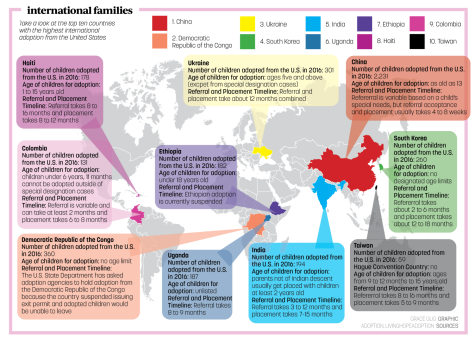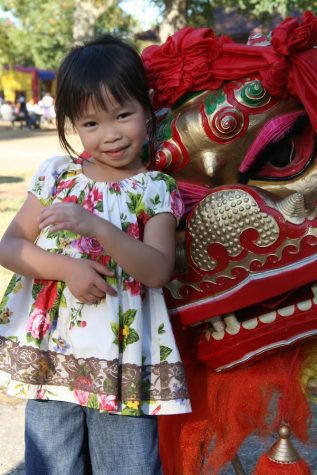As a Black individual adopted into a white family, history teacher Joshua Peterman said he witnesses first-hand the way he is treated differently from his family members.
“Because both of my parents are white and I’m Black, it led to some issues—not between me and them, (but) I went through a lot of stuff especially in high school that they didn’t understand,” Peterman said. “I went to a really rural school so I was the only non-white person in my grade. I mean (my parents) did the best they could (to understand me) but they had never experienced something like (racism) before.”

Peterman’s experience is not an anomaly. According to a study on Korean-born adoptees by the Evan B. Donaldson Adoption Institute, 80% of participants reported race-based discrimination from strangers. Like Peterman’s experience with racism, senior Emily Hahn, who was adopted from China, said she has had experiences where she has been a victim of Asian hate.
“In Spanish class of freshman year, I didn’t really know anyone in the class, there was assigned seating, and I was seated around some people that were very racist in general,” Emily said. “Since I am open about being adopted, I remember they asked me some question and I told them I was adopted. They said some really offensive things after, and I didn’t take it well because it was the first time I had ever experienced anything like that so it was weird.”
Counselor Ann Boldt, who adopted her daughter Alyssa from China, said people have asked her daughter inappropriate questions as well.
“One question I’ve heard adoptees be asked is, ‘How much did you cost?’ That’s very insensitive,” Boldt said. “Alyssa’s been asked a few others as well like, ‘Are you her real parents?’ that type of thing. And we’re like, ‘Yeah we’re her real parents; we’re the ones.'”
Emily’s mom Lynne Hahn said their family has conversations about such acts of discrimination.
Mrs. Hahn said, “People do make insensitive comments, especially when she was younger. One lady said that we saved her because they kill their daughters in China right in front of Emily at a concert. When people are rude, I remove Emily from the situation immediately. When they are ignorant but really trying, I may engage and try to educate. But usually, we like to discuss these things in private as a family.”
In fact, Boldt said “saving the child” is a common stereotype about transracial adoption.
“I think the biggest (stereotype) is that you’ve saved them. To me, adoption is a gift (that) created our family but it’s not a gift neatly wrapped up in a bow,” she said. “One of the best things that (our adoption agency) said is don’t look at yourself as the knight in shining armor. The child’s adoption story does not end as soon as you get off of the plane in your home country. You’re now going to raise a child who is from two families and cultures.”
In addition to being subject to stereotypes, sophomore Anuj Gupta said also people question his relationship with his family. Anuj was adopted from an orphanage in India when he was 18 months old.
“Sometimes we will go somewhere in public with me and my siblings and my whole family, and my sibling will see one of their friends they aren’t close to and my sibling will be like, ‘This is my family,’ and I can see that small weird look (on their friend’s face) that says, ‘Is that your brother?’” Anuj said.
Peterman said people did not understand the dynamic of his family.
“(They) judged my parents or judged me, you know, just because I happen to have a different skin color than them. Especially with transracial adoption, there’s always a connotation like, ‘Yeah, well you’re not their real son,’ because people don’t understand and they don’t get it because they think blood makes family,” Peterman said.
Likewise, from a parental perspective, Anuj’s mom Christine Gupta said she looks at Anuj as if he was her biological son.
“I am not sure if people realize that (your adopted child) feels exactly like your biological kids to the parent,” Mrs. Gupta said. “I will still sometimes make a mistake and say something about being pregnant four times. I have four kids but only three biological (ones) but I (often) forget that.”

With the challenges such as discrimination that may come with transracial adoption, Emily and Boldt said families should consider race or culture as a factor when adopting.
“I feel like it’s different for every child but I feel that (families should consider it),” Emily said. “They need to consider things about the child’s background and cultures so they can expose their child to their culture if the child wants to ever look more into it. I just think there should be lots of research done before someone adopts a child.”
Peterman and Anuj said they disagreed with Boldt and Emily. Kids, Peterman said, need families.
Peterman said, “There are so many kids that need homes and families that would love and appreciate them so race doesn’t matter. If you are willing to adopt, it doesn’t matter what that kid looks like because you are gonna love them, hopefully. My parents have never treated me as anything but a son.”
Ultimately, in light of National Adoption Month in November, Mrs. Hahn and Mrs. Gupta said transracial adoption is complex.
Mrs. Hahn said, “Multicultural families draw attention and it’s impossible to hide that the family was formed in a different way. It’s important to consider that and how you plan on fitting your child’s culture into your family before you move forward with the process. However, if a child needs a home and a family wants a child, cultural differences should not be a deterrent. We fully knew that (our family would draw attention) when we decided to grow our family in this way and I wouldn’t change it for the world.”
This is the third part for this story. Find the first and second parts here.
































![What happened to theater etiquette? [opinion]](https://hilite.org/wp-content/uploads/2025/04/Entertainment-Perspective-Cover-1200x471.jpg)














































![Review: “The Immortal Soul Salvage Yard:” A criminally underrated poetry collection [MUSE]](https://hilite.org/wp-content/uploads/2025/03/71cju6TvqmL._AC_UF10001000_QL80_.jpg)
![Review: "Dog Man" is Unapologetically Chaotic [MUSE]](https://hilite.org/wp-content/uploads/2025/03/dogman-1200x700.jpg)
![Review: "Ne Zha 2": The WeChat family reunion I didn’t know I needed [MUSE]](https://hilite.org/wp-content/uploads/2025/03/unnamed-4.png)
![Review in Print: Maripaz Villar brings a delightfully unique style to the world of WEBTOON [MUSE]](https://hilite.org/wp-content/uploads/2023/12/maripazcover-1200x960.jpg)
![Review: “The Sword of Kaigen” is a masterpiece [MUSE]](https://hilite.org/wp-content/uploads/2023/11/Screenshot-2023-11-26-201051.png)
![Review: Gateron Oil Kings, great linear switches, okay price [MUSE]](https://hilite.org/wp-content/uploads/2023/11/Screenshot-2023-11-26-200553.png)
![Review: “A Haunting in Venice” is a significant improvement from other Agatha Christie adaptations [MUSE]](https://hilite.org/wp-content/uploads/2023/11/e7ee2938a6d422669771bce6d8088521.jpg)
![Review: A Thanksgiving story from elementary school, still just as interesting [MUSE]](https://hilite.org/wp-content/uploads/2023/11/Screenshot-2023-11-26-195514-987x1200.png)
![Review: "When I Fly Towards You", cute, uplifting youth drama [MUSE]](https://hilite.org/wp-content/uploads/2023/09/When-I-Fly-Towards-You-Chinese-drama.png)
![Postcards from Muse: Hawaii Travel Diary [MUSE]](https://hilite.org/wp-content/uploads/2023/09/My-project-1-1200x1200.jpg)
![Review: "Ladybug & Cat Noir: The Movie," departure from original show [MUSE]](https://hilite.org/wp-content/uploads/2023/09/Ladybug__Cat_Noir_-_The_Movie_poster.jpg)
![Review in Print: "Hidden Love" is the cute, uplifting drama everyone needs [MUSE]](https://hilite.org/wp-content/uploads/2023/09/hiddenlovecover-e1693597208225-1030x1200.png)
![Review in Print: "Heartstopper" is the heartwarming queer romance we all need [MUSE]](https://hilite.org/wp-content/uploads/2023/08/museheartstoppercover-1200x654.png)


